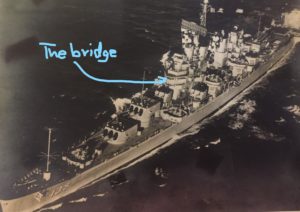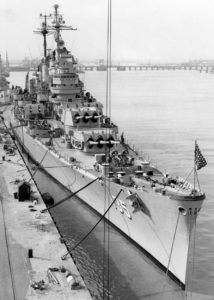When the USS Los Angeles (CA-135) played war games about a dozen men stood watch on the bridge, including the Officer and Junior Officer of the Deck, the Boatswain’s Mate of the Watch, and a Quartermaster. Most of the others were phone talkers, each of them a “conn” –meaning the man in charge — of a network of phone talkers.

The bridge was wrapped around what amounts to a bunker to protect the helm and helmsman. In combat the phone talkers and some of the others would have crowded in there with him.
Although the helmsman worked in a bunker-like compartment there were slits in the bulkhead so he could hear when an officer ordered him to change course.
On the midwatch, midnight to 4 a.m., the bridge was usually warm and quiet, except for muffled hum of the engines and the soothing noise made by wind and waves against our ship. It was hard not to go to sleep. Did you know that if you are tired enough you can go to sleep standing up? It was those times that one of the officers would sometimes test the helmsman.
In a whisper, so the helmsman couldn’t hear, he would order me, “Tell after steering to take control of the ship.”
Normally the helmsman steered the ship but if the helm was knocked out in combat, or knocked out by an electrical failure that could happen any time, the ship could be controlled by “after steering,” men stationed in a compartment in the aft of the ship, close to the rudder.
I would press the button on my phone and whisper, “After steering, conn. Take control of the ship, steering course…” and I would repeat the order the officer had given me.
The officer would then look at this watch, timing the helmsman to see how long it took him realize what had happened and sing out: “Sir, I’ve lost control of the ship.”
And it had better not be long.
Coming Monday: Glimpses of Father
